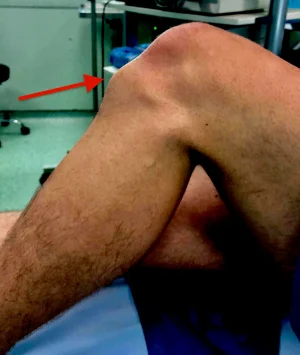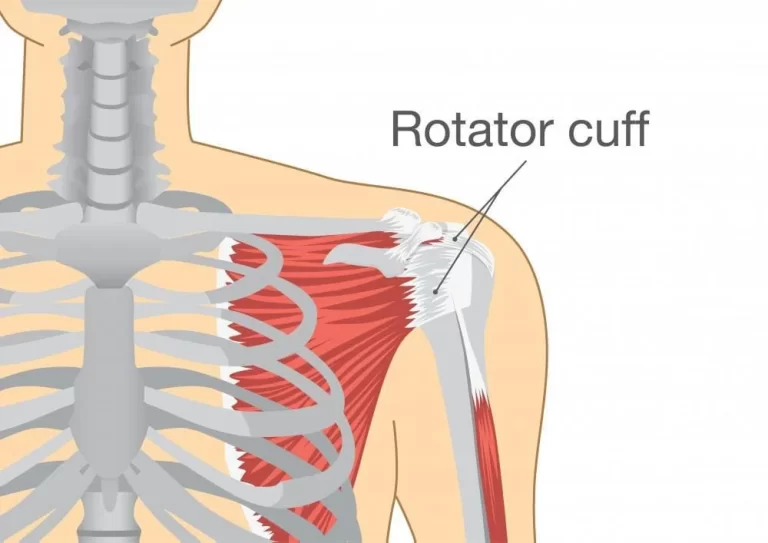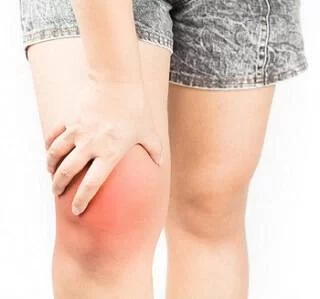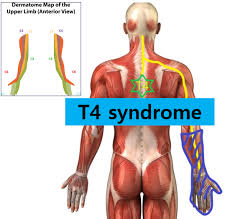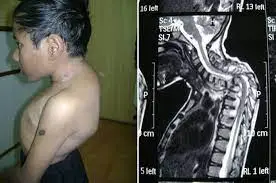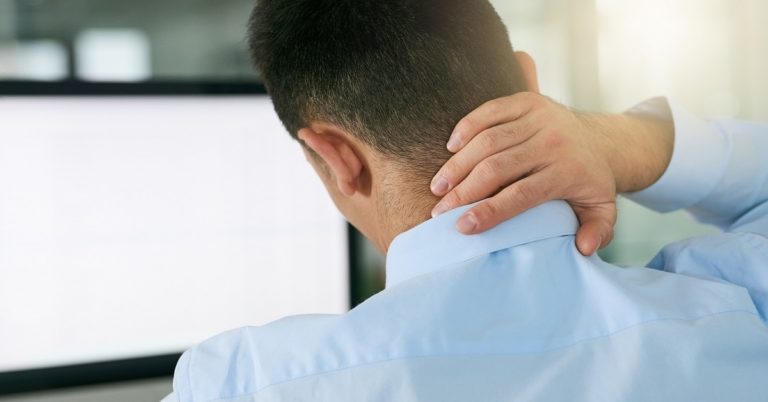Tibial Tubercle Apophysitis
Table of Contents
What is Tibial Tubercle Apophysitis?
Tibial tubercle apophysitis, also known as Osgood-Schlatter disease, is a common condition that affects the knees of adolescents involved in physical activities such as sports. It is an overuse injury characterized by inflammation and irritation at the tibial tubercle, which is the bony prominence located just below the kneecap (patella). This condition typically occurs during periods of rapid growth and is more common in boys than girls.
The exact cause of tibial tubercle apophysitis is not fully understood, but it is believed to be related to repetitive stress on the growth plate of the tibia (shinbone) where the patellar tendon attaches. This stress can be caused by activities that involve running, jumping, or excessive force on the knee, especially during activities that require frequent changes in direction or sudden stops.
- Tibial tubercle apophysitis, also known as osteochondrosis or Osgood sch-latter’s disease.
- Tibial tubercle apophysitis is a common cause of anterior knee pain in immature skeletal athletic people. frequent sports associated with the condition involve football, Volleyball, Basketball, Sprinters, and Gymnastics Clinical presentation classically associates traumatic, insidious onset of front-side knee pain, with tenderness at the patellar tendon insertion on the tibial tuberosity.
- The condition is tone-limited and occurs secondary to repetitive extensor mechanism stress activities similar to jumping and sprinting.
- In the acute stage, the reduced space of the patellar tendon becomes not clear in radio-graphs because of the soft tissue and muscle swelling. After three to five months, bone fragmentation at the tibial tuberosity.
- In the sub-acute stage, muscle swelling resolves, but the bony structure remains. In the chronic stage, the bone fragment may merge with the tibial tuberosity which may appear normal.
Relevant anatomy
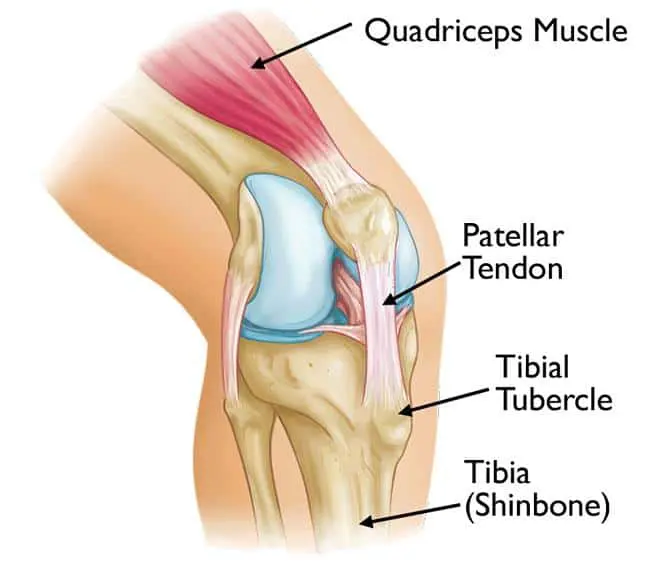
- The tibial tubercle ( the tuberosity of the tibia) is the protuberance along the front surface of the tibia, exactly distal to the front surfaces of the medial and lateral tibial epicondyles. The tibial excrescence is entirely cartilaginous. It is connected to the patellar ligament or patellar tendon.
- The patellar tendon connects to the tibial tuberosity inferior to the patella.
- Pressure at this musculotendinous joint may cause pain and swelling. The pain felt by the patient is generally unilateral, but usually, it’s bilateral.
Causes of Tibial Tubercle Apophysitis
The exact cause of tibial tubercle apophysitis is not fully understood, but it is believed to be related to repetitive stress on the growth plate of the tibia (shinbone) where the patellar tendon attaches. This stress can be caused by activities that involve running, jumping, or excessive force on the knee, especially during activities that require frequent changes in direction or sudden stops.
- Tibial tubercle apophysitis is one of the most prevalent causes of knee discomfort in young athletes with undeveloped skeletons.
- Onset coincides with adolescent growth spurts between ages 10 to 16 years for young males and 8 to 13 years for young females.
- The disorder is more common in men and is more common in sportsmen who participate in running and jumping sports.
- In young athletes, aged 12 to 15, the prevalence of Osgood tibial tubercle apophysitis is 9.8% (11.4% in males, 8.3% in females).
Symptoms of Tibial Tubercle Apophysitis
The primary symptom of tibial tubercle apophysitis is pain and tenderness over the tibial tubercle. The pain is usually worsened with activities that involve bending or straightening the knee, such as running, jumping, or kneeling. In some cases, a bony lump may also be felt or visible at the tibial tubercle.
- Knee pain
- swelling around the knee joint
- Increase pain with activities,
- Decreased pain with rest
- Specifies pain noted at the tibial tuberosity
Who is at risk?
Occurs in skeletally young patients between the ages of 12 and 18 years old age group.
- It’s most generally seen in the 11 to 14-year-old age group. The development of tibial tubercle apophysitis is associated with fast growth and immature bone development in the early 10 years.
- Any teenager in danger who participates in exercise that can exceed the strength of the tibial tubercle by the quadriceps muscle contracting.
- This may happen in high-level sports conditioning that requires frequent running, jumping, or squatting( ie. basketball, volleyball, baseball, soccer).
- It presents in bilateral knees in 20- 30 of individuals, and younger men are affected more frequently than young women
How do you treat the painful knee with Tibial Tubercle Apophysitis?
- The key treatment is RELATIVE REST. This does not mean the disqualification of athletic activities, rather it means alteration and changes of all individual activities, this means possibly curtailing all activities for up to 6 weeks, with the subsequent slow improvement in activities. Other treatments include:
- The primary goal in the treatment of tibial tubercle apophysitis is the decreasing of pain and swelling over the tibial tuberosity. For this reason, patients should limit physical activities until they reduce symptoms, which can sometimes take several months.
- Other conservative therapies include cold packs, nonsteroidal anti-inflammatory drugs (NSAIDs) such as ibuprofen and naproxen (to decrease pain and swelling), protective padding, and physiotherapy.
- Patellar tendon strap: Wearing a patellar tendon strap or brace may help alleviate symptoms by providing compression and support to the patellar tendon.
Medical Treatment
- Conservative treatment: Treatment should begin with rest, icing (RICE), activity modification, and sometimes non-steroidal Anti-inflammatory drugs.
- Nonsteroidal anti-inflammatory:
- Anti-Inflammatory medicine can be used or reduce pain.
- such as Ibuprofen, Naproxen-Aleve, Nuprin, Motrin
- If stomach irritation occurs with this medicine, then Acetaminophen (Tylenol) can be used.
Surgical treatment of tibial tubercle apophysitis
- To avoid growth-plate stoppage and the development of curvature and/or genu valgus of the knee, surgical operations should be avoided until your child has grown up and the bone growth has been finished.
- In surgical treatment, we identified different surgical procedures such as drilling of the tibial tubercle, removal of the tibial tubercle (reducing the size), the longitudinal incision in the patellar tendon, removal of the united ossicle and free cartilaginous part (tibial sequestrectomy), insertion of bone pegs, or a fusion of any of these procedures.
Polar therapy (heat and cold):
- Cold Therapy is initiated for the first 2 to 3 days after activities. This is done using a chemical cold pack, a plastic bag of frozen peas, or ice in a towel. The cold should be applied for 10-20 minutes and off for one hour to minimize potential injury to the skin.
- Heat can be applied not earlier than three days after a complication of knee pain and may be done with hot packs, hot tub baths, or whirlpools.
Physiotherapy Treatment
Assessment
- Painful palpation of the tibial tuberosity.
- Resisted isometrics of the Quadricep muscle are painful.
- Physical activity causes discomfort at the tibial tuberosity or worsens.
- In some conditions, the tibial tuberosity’s bony prominence may be increased.
- Increased pain at the tibial tuberosity with sports activity.
- In addition to pain, Ely’s test also reveals tightness in the quadriceps.
ely’s test
- The patient lies prone in a comfy position. The therapist is standing side to the patient, at the side of the leg that will be tested.
- One hand is placed on the lower back, the other hand holding the leg at the heel. Passively flex the knee in a rapid move. The heel should touch the buttocks.
- Test both sides for comparison. The test is considered successful when the patient experiences pain or tingling in the back or legs, the tested side’s hip rises off the couch, and the tested heel cannot touch the buttocks.
Aims of physiotherapy treatment
- The primary goal in the treatment of tibial tubercle apophysitis is the decreasing of pain and muscle swelling over the tibial tuberosity. The patient should limit physical activities until the symptoms disappear.
- In some cases, the case should restrict physical activities for several months. The presence of pain with kneeling because of an ossicle that doesn’t respond to conservative measures is an indication of surgery. In these cases, the removal of the ossicle, girding bursa, and bony elevation is the treatment of choice.
Immobilization:
- Only if the pain is severe
- A short course of immobilization (i.e. four weeks)
- Removable knee immobile
Exercise for tibial tubercle apophysis
- Quadriceps, hamstrings, and gastrocnemius muscle strengthening exercises are advised. The tibial tuberosity can be relieved by immobilizing the knee (with a cast or brace).
- To avoid stiffness and atrophy, range of motion exercises and knee strengthening are required.
Acute phase
Pain Relief
- The discomfort normally goes away when the development in the tibial tubercle stops.
- Ice application after activity reduces anterior knee pain.
- It is recommended to limit athletic activity for 6-8 weeks.
- Minor stretch to the Quadricep and Hamstring muscle, along with strengthening of the Vastus Medialis Oblique muscle to reduce pain.
- Patellar loading is decreased by patellar tapping/ McConnel tapping, and by the use of a brace.
Isometric exercise
- ATM (ankle-toe movement)
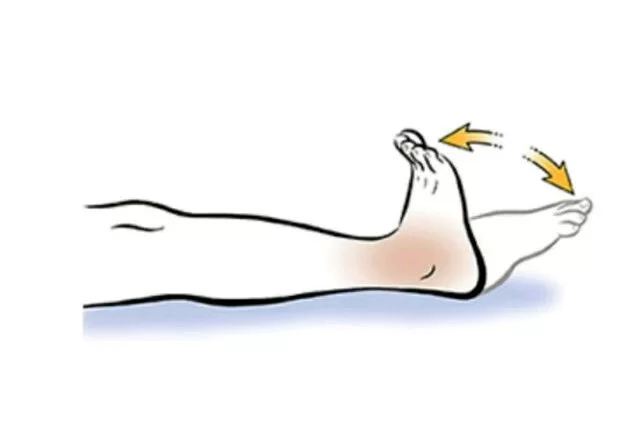
To do this exercise you can start by lying down on a mat with reaming your both legs straight.
Gradually up your Ankle and toes towards you (Dorsiflexion of Ankle and toes) and then lower (Planter flexion of Ankle and toes).
Do 10 to 15 repetitions.
After that, you should rotate your ankle in a circular motion, clockwise and anti-clockwise
Do 10 to 15 repetitions.
Gradually increases the repetition.
2) Short arc quadriceps exercise (VMO)

To do this exercise you require one medium-sized ball or pillow. You are lying on the mat or bed and placing the ball under your knee joint.
Then gradually lift one heel off the floor so the knee joint is straight.
Hold this position for 5 to 10 seconds then slowly lower the leg to starting position.
10-15 repetitions,
Gradually improve the repetition
3) Static quads
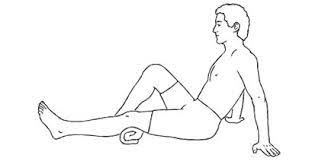
Lie on a mat with the leg straight.
Place a rolled napkin underneath the knee.
Slowly tighten the muscle on the upper of the thigh (quadriceps) and push the back of the knee down into the rolled napkins.
Hold the contraction for 5 to 10 seconds and then slowly back to starting position,
5 seconds rest between each repetition
Perform 3 sets of 10 repetitions, one time a day.
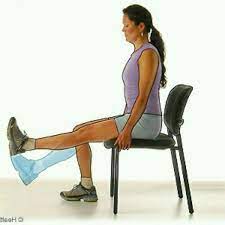
4) Sitting quads
Sit on a chair, and keep your back supported.
Slowly raise your right leg so that it’s parallel to the floor, keeping your left foot on the floor.
Hold for 30 seconds, then slowly return the right foot back to the floor, and repeat on the left leg.
Do 10-15 reps times 2 times a day.
5) Active Heel Slide
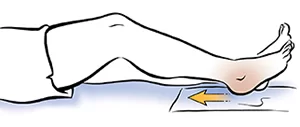
To do this exercise Lie on your back on the mat or bed with place your arms at your sides
Now you can slowly slide your heel as close to your buttocks.
Hold this position for 5 to 10 seconds, Then slowly back to the starting position.
just bend your knee to a limit that is pain-free motion.
You may feel a slight stretch on your knee, but it must be pain-free exercise.
Do 10 to 15 repetitions. 2 times daily.
Gradually increases the repetition.
6) Calf stretch
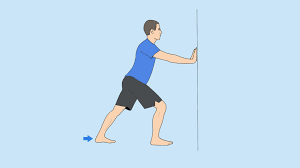
Stand facing a wall with the leg to be stretched behind you and the other leg ahead.
Place your palm on the wall and straighten your hand for support.
Slowly bend the front knee, reaming the heel of the leg behind you down on the ground.
Once you feel a stretch in your calf muscle at the back of your ankle, hold for 25-30 seconds.
Then slowly relax.
Do 3 repetitions.
7) Hamstring Stretch

To perform a Hamstring stretch exercise, you should take a long Sitting position on a soft mat or bed.
Now you should Extend both arms and reach forward by bending at the waist and trying to reach toward the toes- as far as possible while remaining the knees straight.
You should feel a stretch at the back side of your thigh
Hold for 10 – 20 seconds.
Then relax into the starting position
and do 3 repetitions
Sub-acute phase
Strengthening exercise
- Straight leg raising(SLR)

Lie on your back on the mat, with your arms at your sides, the right leg should be banded.
Remain your left leg straight while tightening your leg muscles, and slowly lift up your left leg up to the right side knee level.
Hold and count to 10, then slowly lower your leg to the starting position.
Do 10 reps, do this on the right leg

2) Standing side leg raising
Start this exercise with your hands out before you or resting on your hips. Stand tall with your toes pointed forward. Inhale and move your weight into your right foot as you lift your left leg off the ground with your foot contracted.
As you exhale, bring the leg back down to starting position.
Repeat 10-12 times,
Then do the same on another leg
3) Supine side leg raise
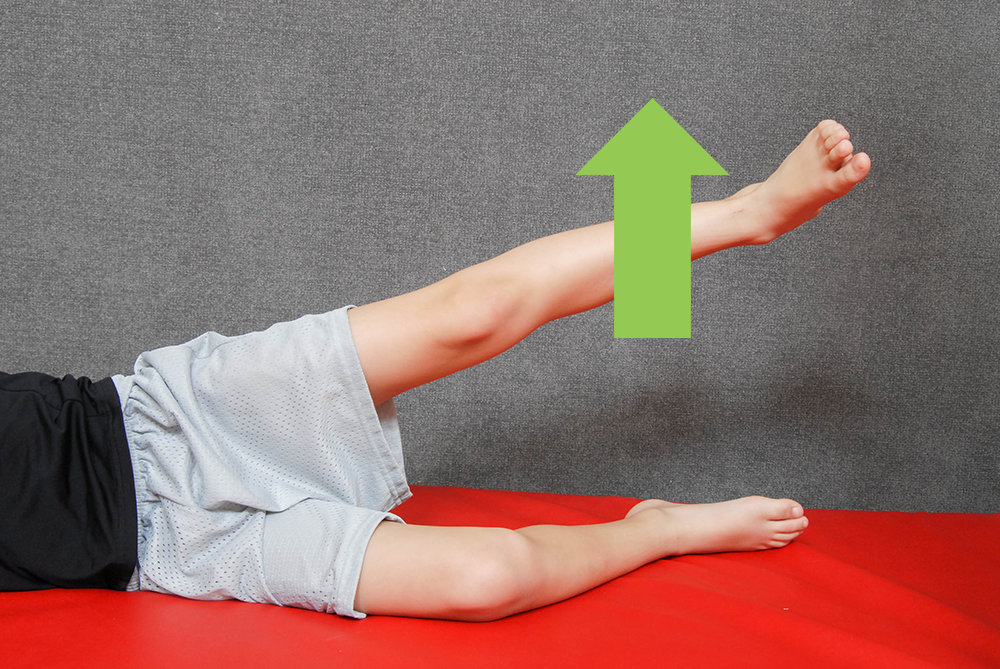
Lie down on your right side on a mat rest or the ground. Your body should be in a straight line with your legs extended and feet touched on top of each other.
Place your arm straight on the floor under your head or bend your elbow and pillow your head for support. Place your right hand out front if you need extra support or let it rest on your leg or hip.
As you exhale, gently raise your right leg off the lower leg. do not raise your leg when you feel the muscles flex in your lower back.
Inhale and lower the leg back down to starting position. touched your feet again.
Repeat 10-12 times, then perform to the other leg.
4) Prone leg raises
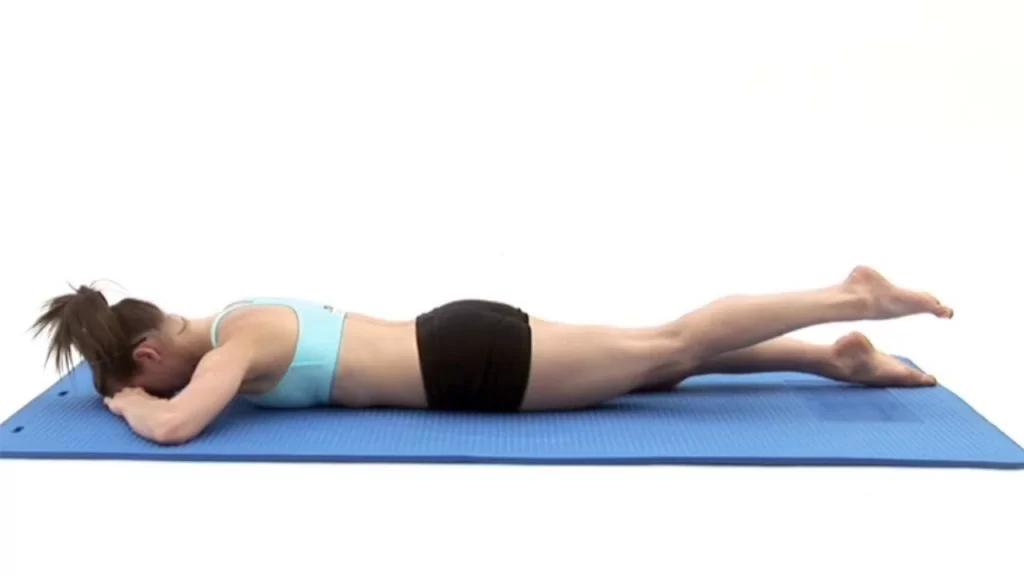
To perform this prone leg raise, you may use a mat rest.
Lie on your stomach with your legs straight. You can let your head resting position on your arms.
Contract your glute muscle and hamstring muscles in your left leg and up your leg as high as you comfortably can without pain. Be sure to remain your pelvic bones on the ground throughout this performance.
Hold your leg in the lifted position for 5 to 10 seconds.
Slowly lower your leg to starting position,
Rest for 2 seconds, then repeat.
Perform 10 to 15 repetitions on both sides.

5) Leg extensions
To do this exercise the patient has to Sit up tall in the chair or table.
Set your feet level on the ground, hip-width apart.
Look straight, contract the thigh muscles, then straighten one leg as far as possible without raising the buttocks off the air.
Pause, then lower to the embarking position.
Do 10 to 15 repetitions,
For progression does more repetitions.
6) Pendular Knee exercise
To perform this exercise you should sit on a chair or bed whose height is slightly high as compared to your leg and your leg is freely hanging on the bed or chair.
your both hands should be placed on both sides of your to hold the bed.
Now gently swing your lower leg alternatively.
Do not do fully straight or flex your leg.
Do 2 to 4 minutes until you feel relaxed.
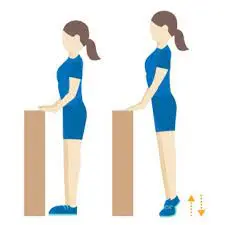
7) Standing heel raise
Stand with your feet about shoulder-width apart.
If you need support use a chair or the wall nearby.
Lift your heels off to the ground so that you’re standing on the toes of your feet.
Slowly lower your heels to the ground.
Do 20 or 25 repetitions on each leg.
chronic phase
- Wall Squats

Start with your back support to the wall with your feet shoulder width and about 2 feet from the wall.
Contract your abdominal muscles and slowly slide your back down the wall until your knee band is 90 degrees and your thighs equal to the floor.
Adjust your feet so that your band knees are parallel to your ankles and not over your toes.
Remain your back flat on the wall.
Hold this for 20 to 25 seconds.
Slide slowly and go up the wall to a starting position.
Rest for 20 to 30 seconds in each repetition and do 10 to 15 repetitions.
Increase your hold time in five-five second increments as you improve your strength.
2) Half squat
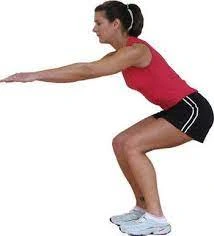
This is the best way to strengthen the quadriceps, glutes, as well as hamstrings muscles without straining the knee joints.
To perform this exercise you take a standing position with the feet shoulder-width apart. Put both your hands on your hips or straighten your hand in front of you for balance.
The patient has to Look straight ahead, gently squatting down about ten to twelve inches. It is the mid-age of a full squat.
Hold for two seconds, then back to the starting position.
Do 10 to 15 repetitions.
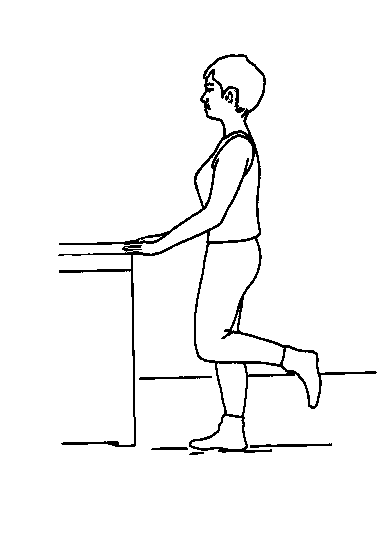
3) Standing hamstring curl
Stand with your feet hip-width apart. Place both your hands on your waist or on a chair for balance.
Shift your weight onto your right leg.
Slowly bend your left knee, bringing your heel toward your buttock. remain your thighs parallel.
Slowly lower your foot.
Complete 12 to 15 reps.
Repeat with the other leg.
4) Seated hamstring curl
Tie the ends of theraband to a stable object, such as an exercise machine or piece of furniture.
Sit in front of the theraband. do the theraband loop around one of your heels and keep your feet together.
Bend your knee to pull your heel back, stopping when you feel pain and can’t pull any further.
Extend your knee back to starting position.
Complete 12 to 15 reps.
Then repeat on the other leg.
5) Prone hamstring curl
Anchor the ends of a theraband to a stable object.
Lie down on your tummy with your feet hip-width apart. tie theraband around your heel and flex your ankle.
Bend your knee to pull your heel toward your buttock, reaming your thighs and hips on the mat.
Stop when you can’t pull any further.
Back to starting position.
Complete 12 to 15 reps.
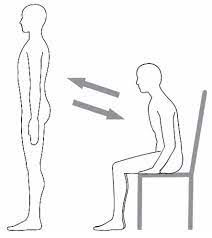
6) Sit to stands
To perform sit-to-stand exercises you need a chair.
Without using the hands for support, stand up and then sit down.
Make sure every movement is slow and controlled balance.
Perform one minute then rest 20 to 30 seconds after repeating another two times.
7) Static lunges

Forward lunges exercise improves the strength of the thighs and hips and maintains balance.
To perform the lunges exercise the patient has to stand with feet- hip-width apart, and reset the fists on the hips.
Now take a forward step. gently lower the hips, and flex both knees but make sure that the front knee does not track over the toes.
Hold for 10 to 15 seconds, then push up off the front heel to return to the starting position.
Repeat 10 to 15
This practice is on the other leg as well.
8) Walking lunges
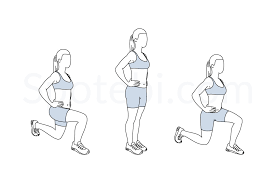
Step ahead with your right leg, and bend that knee at a 90-degree angle.
At the same time, lower the back knee to the floor. Your thigh should be almost equal to the floor.
Hold this for 5 to 8 seconds.
Then take a step ahead with your back leg, and repeat the lunge leading with this leg.
Work up to step lunges per leg.
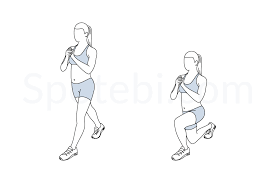
9) Split Squat
To perform the split squat the patient has to come into the staggered stance with feet hip-width apart and one foot positioned several feet in front of the other, the holding dumbbell in their hands.
Engage the core muscles and flex both knees to lower the body into the lunge (or split squat) until the front thigh is parallel to the ground.
Make sure to remain the core tight, spine straight (the trunk can need to lean slightly forward to achieve this, & that is fine), and shoulders back (not hunched up or even rounded ahead).
Push through the heel of the front foot as you straighten that knee and return to starting position.
Perform 10 to 12 repetitions on the same side,
Then switch legs and repeat.
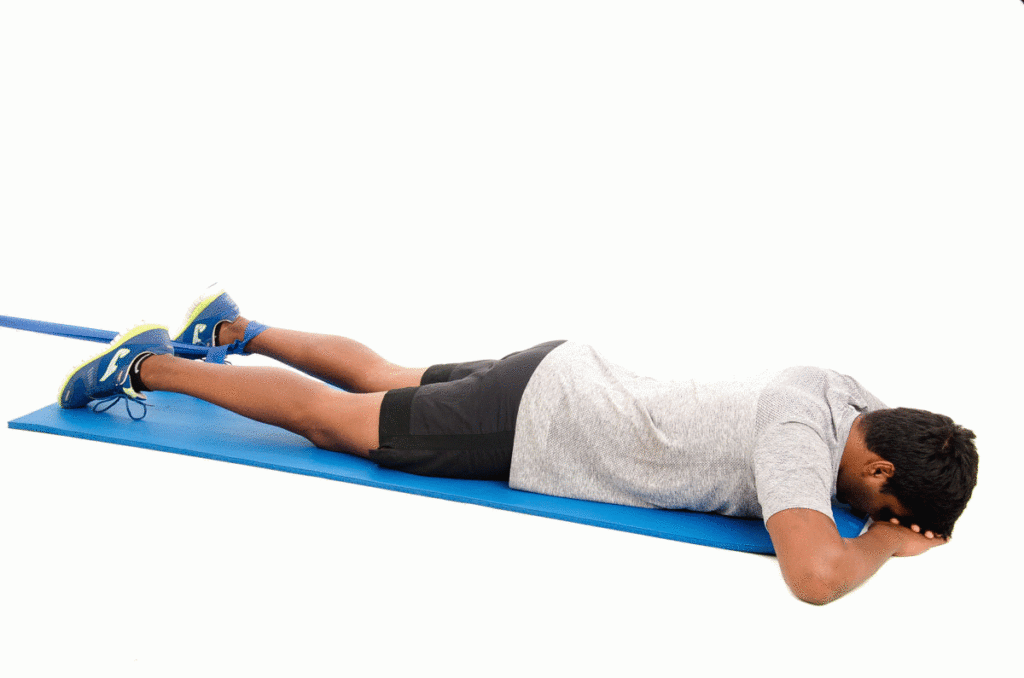
10) Knee banding with resistance band
Lie on the bully legs should be straight, tie one end of the theraband on the leg above the ankle and another end to the stable
Surface near the foot end.
Maintain chin tuck, blade set, and core set. Breathe out, and bend the knee as much as possible. Breathe in, and straighten the bent knee.
Repeat.
Activity Limitation
- Non-surgical therapy of tibial tubercle apophysitis is founded on the same principles that apply to all overuse injuries.
- Today, there is no need for complete immobilization, or for completely refraining from athletic activities.
- Of vital importance is that the doctor informs the parents, the coach, and the child athlete of the natural course of this disease.
- The child should continue his normal day-to-day life activities, to the limit that the pain allows it, so low intensity of frequency of exercising (activity modification). Also swimming, as a secondary athletic activity, is effective during tibial tubercle apophysitis(no discomfort).
- Also, knee braces, tapes, and slip-on knee support with an infrapatellar pad or strap are recommended and may help during day-to-day life activities and can decrease pain.
FAQs
- What is tibial tubercle apophysitis?
Tibial tubercle apophysitis, also known as Osgood-Schlatter disease, is a common condition that affects the knees of adolescents involved in physical activities such as sports. It is an overuse injury characterized by inflammation and irritation at the tibial tubercle, which is the bony prominence located just below the kneecap (patella). This condition typically occurs during periods of rapid growth and is more common in boys than girls.
- What are the causes of tibial tubercle apophysitis?
Tibial tubercle apophysitis is a common cause of anterior knee pain in immature skeletal athletic people. frequent sports associated with the condition involve football, Volleyball, Basketball, Sprinters, and Gymnastics Clinical presentation classically associates traumatic, insidious onset of front-side knee pain, with tenderness at the patellar tendon insertion on the tibial tuberosity.
- What are the symptoms of tibial tubercle apophysitis?
Knee pain
swelling around the knee joint
Increase pain with activities,
Decreased pain with rest
Specifies pain noted at the tibial tuberosity - who is at risk for tibial tubercle apophysitis?
It’s most generally seen in the 11 to 14-year-old age group. The development of tibial tubercle apophysitis is associated with fast growth and immature bone development in the early 10 years.
- what is the best exercise for tibial tubercle apophysitis?
Acute phase
1)ATM
2)Vmo
3)static quads
4)sitting quads
5)hamstring stretch
6)calf stretch
Chronic phase
1)SLR
2)Standing side leg raise
3)supine side leg raise
4)prone leg raise
5)pendular heel
6)hamstring curl
7)lunges

